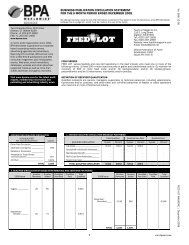February - Feedlot Magazine
February - Feedlot Magazine
February - Feedlot Magazine
- No tags were found...
You also want an ePaper? Increase the reach of your titles
YUMPU automatically turns print PDFs into web optimized ePapers that Google loves.
Daryl Tatum, Colorado StateUniversity animal science professor,reviewed the components ofconsumer demand and how producerscan best deliver the “pleasurableeating experience” forwhich they will pay more. Genotypedetermines the upper limit forintramuscular fat (IMF, or marbling)deposition, Tatum said, butmanagement either preserves orharms marbling potential.Most producers know thatonce cattle have more thanenough energy to meet growth demand,they begin to store the extraenergy as fat. But Tatum saidproducers may not be as familiarwith Kelly Bruns’ South DakotaState University research thatshows marbling is deposited mostrapidly when given the opportunityearly in the feeding period.In fact, a growing body of researchshows a window from two toeight months of age that is criticalfor marbling development. That’swhy it takes coordination throughthe supply chain to realize the qualitypotential in cattle, Tatum said.Otherwise, calves with stunted marblingend up piling on backfat anddeveloping yield grade (YG) problems.One solution is to increase thediscount for YG4s, he added.Fred Owens, Oklahoma StateUniversity emeritus professor andParticipants in the Feeding Quality Forums discussed many of the factors that play arole in delivering higher quality beef to consumers.Pioneer consultant, talked aboutnutrition and a coordinated approachto quality. Cow-calf producersmust start with sire selectionand using feedlot and carcass datato cull cows and manage calveswith preconditioning vaccinationsand weaning so they are ready forthe stocker phase, Owens said.Stockers and feedlot operatorsshould buy or feed only tame cattlewith known and appropriatehealth and nutritional background,use no implants, sort finished cattleto outcome and return all datato the ranch of origin, he added.Pfizer veterinarians Lonty Bryantand John Pollreisz, along with nutritionistGary Sides, provided specificsolutions to many of the qualitychallenges. “Feeders sometimeswant all products, such as de-wormers,to be the same so they can leastcosteverything,” Pollreisz said.“That can lead to disaster.”As the industry moves toyounger cattle and strives for evergreaterefficiency, Pollreisz andBryant said feeders must askwhether efficiency and quality areopposing traits, and if quality hasreceived enough priority.Sides advocated a holistic approachthroughout the productionsystem and reviewed the “energeticsof growth and marbling.” Using emptybody fat as a fixed percentage,Sides showed that growth implantsmay be useful in helping some cattlereach heavier carcass weights. Healso noted Iowa State University researchthat suggests implants shouldbe matched with protein source tooptimize quality grades. ♦Specializing In:Turn-Key Feedyard Construction• Hog Site Construction • CompleteDairy Construction • Sprinkler SystemCAD Engineered Design • GPS Survey• Slipform Concrete Feedbunks • Dirtworkof All Types • Laser-Equipped Machinery• All types of FencingCircle No. 114 on ReplyFEED•LOT <strong>February</strong> 2007 13



